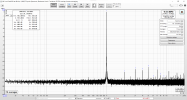Sorry if this technical question has already been answered elsewhere but maybe someone can help my understanding?
Let’s say we have a DAC with a dynamic range of say 124dB, which means that -125dB and lower all we’ve got is noise (probably thermal noise). How then can we measure for example jitter noise/artefacts at say -140dB (or lower in some cases) at the DAC’s output? Wouldn’t it be buried 15dB below the DAC’s noise floor?
TIA.
Let’s say we have a DAC with a dynamic range of say 124dB, which means that -125dB and lower all we’ve got is noise (probably thermal noise). How then can we measure for example jitter noise/artefacts at say -140dB (or lower in some cases) at the DAC’s output? Wouldn’t it be buried 15dB below the DAC’s noise floor?
TIA.


